

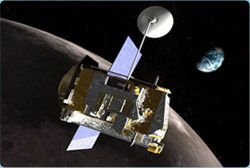
This spacecraft is designed for precise mapping of lunar surface topography, information that will be essential for future human lunar exploration and extended stays on the Moon. Orbiting the Moon at a low attitude of 50 km, the probe will obtain high-resolution images of the lunar surface and investigate lunar resources. Its main focus will be seeking evidence of water ice in the lunar polar region. The Lunar Reconnaissance Orbiter is scheduled for launch in the fall of 2008.
(Courtesy of NASA)
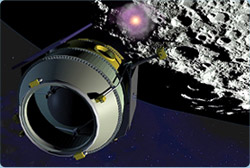
This satellite will search for water in the permanent shadow of craters at the lunar South Pole. It is designed to be steered into a crater, where it will analyze material scattered by its own impact. LCROSS is to be launched at the same time as the Lunar Reconnaissance Orbiter, in the fall of 2008.
(Courtesy of NASA)
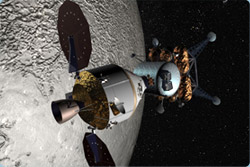
NASA is aiming to launch the next-generation crew exploration vehicle Orion by 2020. Orion accommodates four crewmembers, and will travel to the surface of the Moon after docking in lunar orbit with a lunar landing craft, which will be launched on the Ares V cargo launch vehicle. NASA plans to carry out a manned test flight by 2014.
(Courtesy of NASA)
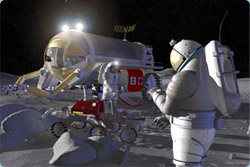
An international project, planned for completion by around 2024. A base is to be built at the lunar polar region, which will accommodate astronauts for six months at a time. The facility will also be used as a base for future missions to Mars.
(Courtesy of NASA)

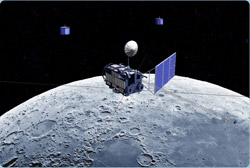
A lunar orbiter designed to study the origin and evolution of the Moon, SELENE consists of a main satellite and two sub-satellites. It is equipped with 15 scientific instruments for observing the distribution of elements and minerals on the lunar surface, the lunar topography, the interior structure, and lunar magnetic fields. After separating from the main satellite, the sub-satellites will relay radio waves to Earth, transmitted from the main satellite while it flies over the far side of the Moon. Gravity fields on the lunar far side will be measured for the first time. SELENE is to be launched in summer 2007.

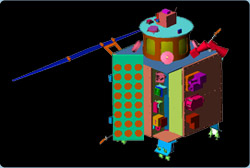
This lunar orbiter is designed to map lunar topographic features and mineral distributions. Chandrayaan-1, scheduled for launch in early 2008, will search for water at the lunar South Pole, and conduct precise observation of the lunar surface. Its observation instruments include devices developed by NASA and the European Space Agency. Subsequent missions are under consideration, including a soft lunar lander called Chandrayaan-2, a sample-return mission, and a human lunar exploration mission. Chandrayaan means Moon Craft in Sanskrit.
(Courtesy of ISRO)


This lunar orbiter will observe lunar topography and element distribution. Its survey of the Moon's environment will include acquisition of three-dimensional images of the lunar surface. Chang'e-1 is scheduled for launch in spring 2007.
(Courtesy of CNSA)
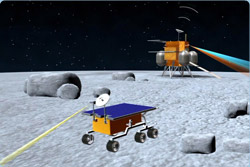
This is a soft lunar lander. China is also considering sending a rover for further study of the lunar surface. This spacecraft is scheduled to be launched around 2010.
(Courtesy of CNSA)
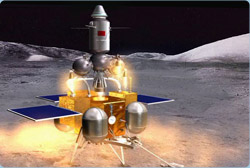
A lunar sample return probe is planned for launch around 2012. Future human lunar exploration is also under consideration.
(Courtesy of CNSA)


This lunar orbiter surveys the lunar surface and inner structure by placing four penetrators on the lunar surface. Russia is aiming for a launch around 2012.
(Courtesy of Lavochikin Association)
>>Return to Top
Special Interview
>>Hitoshi Mizutani >>Paul D. Spudis >>Carle Pieters >>Wendell W. Mendell >>Bernard H. Foing
>>Lunar Explorers Around the World
Special Interview
>>Hitoshi Mizutani >>Paul D. Spudis >>Carle Pieters >>Wendell W. Mendell >>Bernard H. Foing
>>Lunar Explorers Around the World